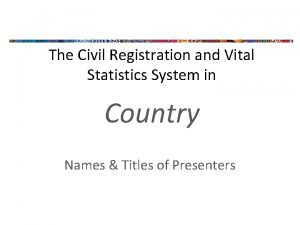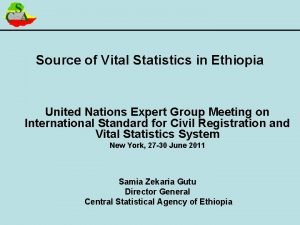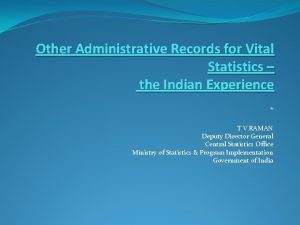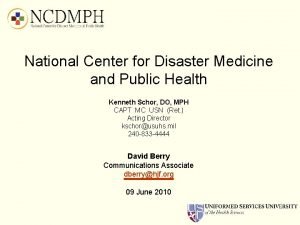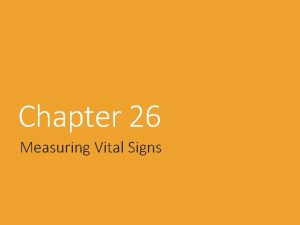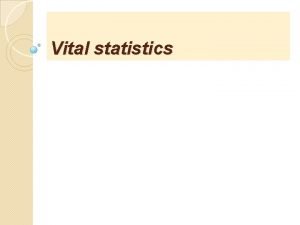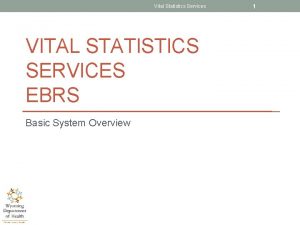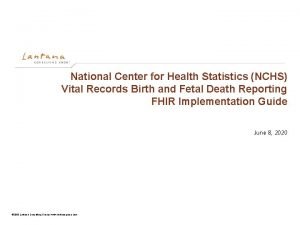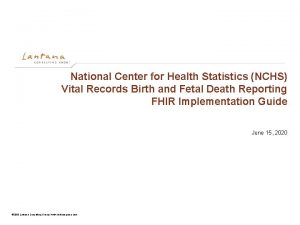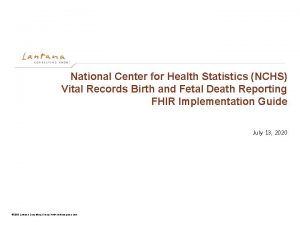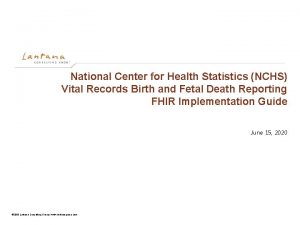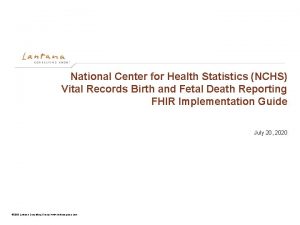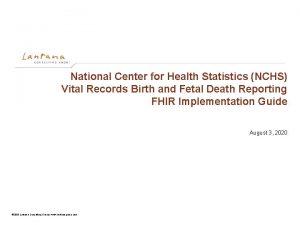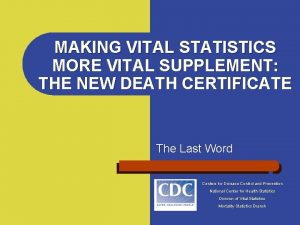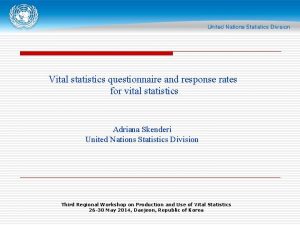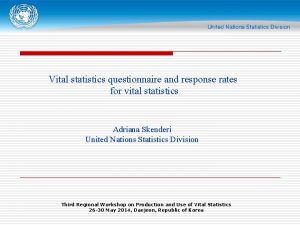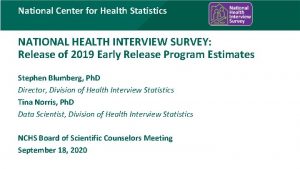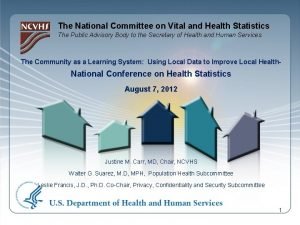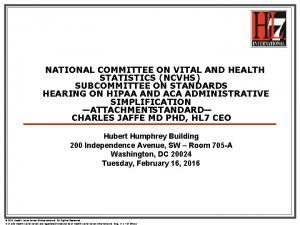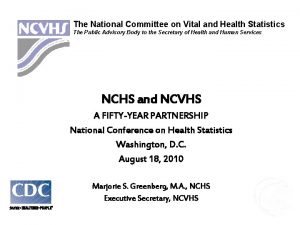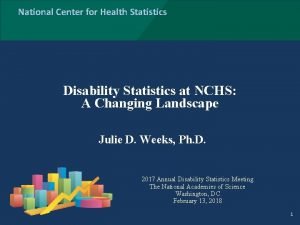National Center for Health Statistics National Vital Statistics


























- Slides: 26

National Center for Health Statistics National Vital Statistics System Behind the Scenes Board of Scientific Counselors Meeting September 5, 2019 Steven Schwartz, Ph. D. Director, Division of Vital Statistics

The US Constitution Amendment X The powers not delegated to the United States by the Constitution, nor prohibited by it to the States, are reserved to the States respectively, or to the people. Amendment XIV Section 1. All persons born or naturalized in the United States, and subject to the jurisdiction thereof, are citizens of the US and of the State wherein they reside.

Goal of today’s presentation Behind the scenes look at how we obtain and continually maintain timely and high quality vital statistics A peek into the challenges & progress to date

The workload • 3. 8 million births • 2. 8 million deaths • 24 k fetal deaths > 20 weeks gestation • 57 Vital Registration jurisdictions • The Vital Statistics for the United States

National Vital Statistics System Oldest and most successful example of intergovernmental data sharing in Public Health NCHS/DVS States, DC, NYC and territory vital statistics Standards & procedures NVSS https: //www. cdc. gov/nchs/nvss/about_nvss. htm

Retail v. Wholesale: The Retail Side • Customer needs: Certified copies of birth, death, marriage, divorce certificates • Name changes, transgender birth certificates, paternity acknowledgements, corrections and amendments • Burial, transit and disinterment permits • Funeral directors • Internet ordering

The Wholesale Side: Public Health Data • The data providers are the doctors, hospitals, nurse midwives, and funeral directors • Where do race, ancestry, industry and occupation data come from? Funeral directors • What guarantees that all US vital events are reported? • The customers need the certificates!

Follow the money • NCHS pays states for the data, >$21 M in total, across the 57 jurisdictions/year • A large jurisdiction may be paid about $600, 000/year from NCHS (wholesale) • The retail side collects about $15 M/year on the sale of certificates, corrections, amendments and burial permits • Plus, the states have to watch the books

States Change Slooooowly 2003 U. S. Standard Certificates - 50 states implemented • Birth Certificate - 2016 • Death Certificate – 2018 • Report of fetal death - 2018

State Laws and Systems Vary • Timelines for registration vary • Registration methods very • Data items may be collected differently • Who has authority to provide or amend information? • Electronic systems vary in their implementation and contracts

Other ways vital statistics are different than other public health data systems? • Collected on a more frequent basis than most (states send daily or several times a week) • Updates to NCHS are sent – sometimes by mistake and need to be monitored • Most CDC programs use cooperative agreements, we purchase the data via contracts

Vital Statistics Cooperative Program (VSCP) Contract • NCHS produces national vital statistics by purchasing data from 57 jurisdictions • Includes births, deaths, fetal deaths, and linked births and infant deaths • Requires use of US standard certificates and edit checks

VSCP Contractual Requirements • Ongoing timeliness of births, deaths and fetal deaths • E. g. , 85% of births within 10 days • Final file closeout deadlines • Births – March 1 • Deaths & Fetal Deaths – May 1 • Cannot exceed thresholds for unknown values by item • Respond to any issues identified within 30 days • Maintain a Quality Assurance Program • Optional tasks as funding allows (“Special Projects”)

Division of Vital Statistics, NCHS Data Acquisition, Classification and Evaluation Deputy Director Information Technology Director Mortality Statistics Reproductive Statistics

Data Acquisition, Classification and Evaluation Branch • Administers the VSCP and National Death Index contracts, including funded Special Projects • Monitors and evaluates status of deliverables on an ongoing basis • Codes causes of death and fetal death and returns the codes to the jurisdictions • Contract requires that coded records be returned to the jurisdiction within 10 days.

DACEB Statistical Team Vacant, Team Lead Vital Statistics Specialists Chrissy Jarman, Team Lead Karen Knight Branch Chief Medical Classification Specialists Matt Rowe, Team Lead Medical Record Technicians Carissa Haney, Acting Team Lead

Ongoing Monitoring and Evaluation Activities • Monitor the database daily for state file updates, missing or skipped shipments • Identify new errors or issues in the content or volume of data • 10’s of thousands daily for each data year • Identify file transmission stoppages from states, and help locate the problem – the state, STEVE, CDC systems or our system.

• Send states reports on data that fail NCHS edits, missing records, egregious data quality issues • Evaluate completeness of all files, linkage between births/deaths for infant deaths • Send reports on low survival births & other tools to identify unlinked infant deaths

• Evaluate unknown values over tolerance by field (weekly reports) • Quarterly analysis of over- or under reporting on birth items at state and facility level • Suspicious patterns in data reporting, e. g. , potential use of system defaults or incorrect collection • To be used by the state in their QA program • Contract requires a response/resolution in 30 days • Reports information to publication Branches to inform data use restrictions.

Source of Birth Data Quality Issues • Source of the issue often at facility level • Over 3500 birthing facilities in the US. Birthing Facility Distribution, 2018 Births 100% 90% 80% 70% 60% 50% 40% 30% 20% 10% 0% <2499 births 2500+ births % Facilities % Births

Cause of Death Data Quality processed separately • Code to ICD-10 – multiple and underlying causes & answer state questions • Many processing errors on this part of the file because of the multi-step process to auto-code • Identify and confirm rare causes with CDC partners and the jurisdiction • Identify ways to improve a state’s auto-coding rate • Provide information to support a state’s QA program / promote NCHS e-learning / system improvements Almost all ICD-10 mortality expertise is at NCHS!

Cause of Death Data Quality • Follow-up on pending causes of death • Analyze and report on blank or underreported fields that affect coding to the ICD-10 rules. (e. g. , blank pregnancy or manner of death checkboxes, etc. ) • Identify and correct errors in coding Manually reviewed >25 K for 2018 data year!

Staff monitor, evaluate and code data on a daily basis and work closely with states to • Identify data issues early and manage ongoing contract performance • Help states troubleshoot the source of the problem: • Systems, Processes, Incorrect edits or defaults, Facility reporting, Certifier Reporting, Etc. , etc. ! • Impress the importance of faster resolution – since the data is used on an ongoing basis

Summary of Challenges • Not all states collect information the same way or on same timelines. • Did not use standard certificates or edits in new systems; may use defaults or not fully tested before implementation • Data providers at birthing facilities may not understand the importance, or what to enter on a birth certificate • Many cause-of-death certifiers are poorly trained, or only certify a few a year • High pending causes of death from a ME/coroner shortage • High staff turnover, staff shortages

Yet, major progress has been made by • Collaborative efforts with NAPHSIS and the states • Our DACEB staff orient new state staff to vital statistics and what’s expected for the VSCP • Creating and targeting analyses and reports to help states with data quality follow-up • Promotion of E-learning for data providers • Special Projects to address mortality timeliness and quality • Files are closed faster than ever and generally of better quality • Data available on an ongoing basis for surveillance

State Vital Statistics Improvement Cooperative Agreement Activities • Birth Data Quality Workgroup • Recommended dropping non-performing items from birth and fetal death file • Promotion of e-learning training module • Mortality Data Quality Workgroup, analysis and prioritization of data quality issues • Training of new registrars, new state staff, and Field Services training • Monthly calls with state leadership • Development and technical assistance for new PHAB Accreditation Standards for vital statistics
 Capacidad vital y capacidad vital forzada
Capacidad vital y capacidad vital forzada Vital statistics
Vital statistics Civil registration system
Civil registration system Source of vital statistics
Source of vital statistics Vital statistics
Vital statistics National center for disaster medicine and public health
National center for disaster medicine and public health National program for child health
National program for child health Kontinuitetshantering i praktiken
Kontinuitetshantering i praktiken Novell typiska drag
Novell typiska drag Nationell inriktning för artificiell intelligens
Nationell inriktning för artificiell intelligens Ekologiskt fotavtryck
Ekologiskt fotavtryck Shingelfrisyren
Shingelfrisyren En lathund för arbete med kontinuitetshantering
En lathund för arbete med kontinuitetshantering Underlag för särskild löneskatt på pensionskostnader
Underlag för särskild löneskatt på pensionskostnader Tidbok för yrkesförare
Tidbok för yrkesförare A gastrica
A gastrica Vad är densitet
Vad är densitet Datorkunskap för nybörjare
Datorkunskap för nybörjare Stig kerman
Stig kerman Mall för debattartikel
Mall för debattartikel Delegerande ledarstil
Delegerande ledarstil Nyckelkompetenser för livslångt lärande
Nyckelkompetenser för livslångt lärande Påbyggnader för flakfordon
Påbyggnader för flakfordon Vätsketryck formel
Vätsketryck formel Svenskt ramverk för digital samverkan
Svenskt ramverk för digital samverkan Lyckans minut erik lindorm analys
Lyckans minut erik lindorm analys Presentera för publik crossboss
Presentera för publik crossboss


